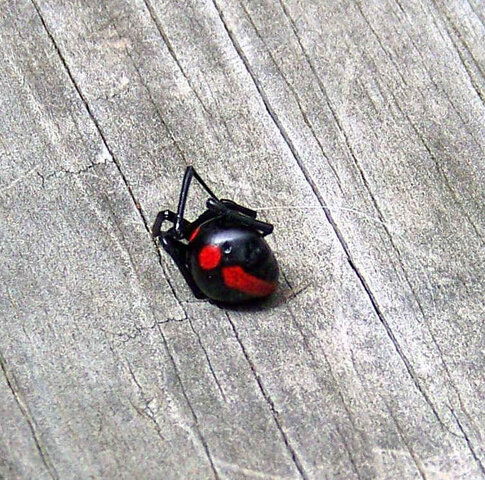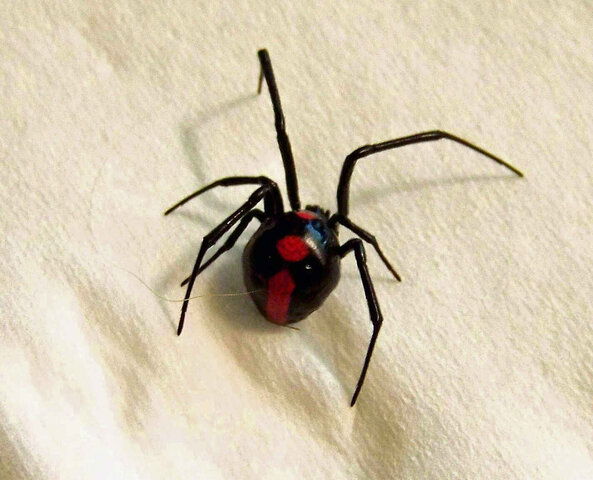I usually like to live in harmony with the critters that live out in the woods with me, but the exterior of the house would be one big spider web if I didn't acutally use pesticide directly on the house and eaves. Unfortunately, the following victim was found after she'd taken a fatal hit of the poison.
I've seen black widows many times, and they usually have a classic hourglass design on their underbellies, but this one had a variation on it's back I'd not seen before. Can anyone expound upon this? Is this perhaps a species that mimics the potentially harmful Black Widow?
Home >
The Animals >
Spiders >
Australian Spiders >
Red-back Spider  Scientific Name:
Scientific Name: Latrodectus hasselti
The red-back spider is closely related to the black widow spider of the United States and the katipo of New Zealand. The female red-back is black with a distinctive red or orange marking on its back, although this may sometimes be absent. These markings may be broken into spots in front and, sometimes, thin white lines may be visible. The female can grow up to 15mm long. Males are very small and usually only grow up to 5mm long. The female is the only one capable of harming humans as the male's fangs are incapable of penetrating human skin. The male is short-lived and has more complex markings than those of the female, incorporating white and sometimes yellow markings.
Did You Know? Like its famous relative, the black widow spider, the female red-back is certainly not adversed to making a meal out of the hapless, smaller male of the species after mating. It is thought that this maybe why males are so small so they can approach the female undetected and possibly have a better chance of escape after the job has been completed.
Habitat: Red-back spiders can be commonly found in logs or under rocks in the bush as they tend to reside in dark, dry areas. In suburban regions, the red-back has been known to live under roof eaves, floorboards, shelves, flower pots or in garden sheds. The web is a tangle of dry silk. The traplines are sticky to assist with catching their prey.
Diet: Red-backs eat almost any small insects that are caught in their webs. They will also eat skinks and even juvenile mice, snakes and frogs. Red-back spiderlings will also eat their siblings. The red-back spider weaves a snare-like structure that traps prey walking on the ground beneath the web. Its spring-like action traps the animal into the small web above, where it cannot escape from the traplines that are covered with sticky globules.
Reproduction: Female red-backs take about 2-3 months to mature and can lay 3-8 egg sacks between September and May. Each sack can contain up to 300 eggs. However, most of the hatchlings do not survive because they are eaten by their siblings and are very prone to wasp parasitism.




 Scientific Name: Latrodectus hasselti
Scientific Name: Latrodectus hasselti 